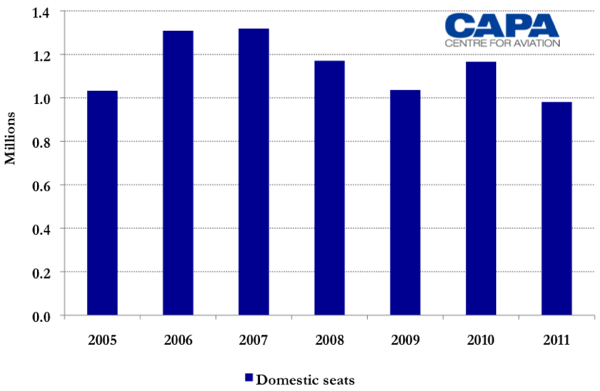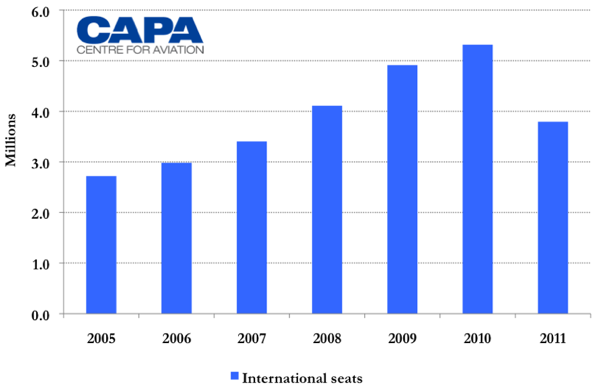Rebuilding Libya's aviation industry crucial to economic recovery
Even before the NATO air strikes, the United Nations sanctions and the European Union ban, Libya's aviation industry had little hope. The country, ruled by Muammar Gaddafi under an iron fist for the last 40 years, placed little focus on its airlines and airports, while countries in the nearby Middle East flourished and started to develop some of the largest hubs in the world. The Middle East/North African region has become increasingly important but it seems Libya was left behind, and when major unrest broke out in Feb-2011, the industry's problems widened significantly. Now Libya has been "liberalised" and Gaddafi killed, it must begin the slow process of rebuilding an industry whose foundations were not strong to begin with. International airlines have resumed services, investment firms are showing interest in relaunching airport renovation projects, the country's two national carriers have relaunched operations and are set to resume talks on their merger, and tourism operators are becoming optimistic about future bookings.
Inspired by the Tunisian and Egyptian revolutions, the unrest in Libya is part of the greater Arab Spring, which has seen the leaders of Egypt, Tunisia and now Libya overthrown. Aviation in these countries during the unrest was unstable, however, Tunisair and EgyptAir have successfully restored operations to full capacity. In Feb-2011, Cairo International Airport recorded 530,000 passengers - a 54% drop from Feb-2010. The airport is now operating at near-2010 capacity, and in Jul-2011 and Sep-2011, passenger traffic surpassed 2009 levels. Libya's Monastir Habib Bourguiba International Airport and Enfidha Zine El Abidine Ben Ali Airport, both operated by TAV Holdings, have been recording consistent traffic decreases of between 30% and 50% each month.
Two main Libyan carriers back in the air, and could be one by 1H2013
Afriqiyah Airways, one of two state-owned carriers, resumed operations on 01-Dec-2011 to destinations including Cairo, Tunis, Istanbul, Dubai, Alexandria, Faro and Khartoum, however, is still unsure whether it will keep its sub-Saharan network (CEO Rammah Ettir stated most routes were unprofitable, except for Lagos and Accra). While the carrier plans to resume full operations shortly, Mr Ettir anticipates a difficult process due to the damage caused to the airline's fleet. Between Mar-2011 and Aug-2011 the company was "focussed on repairing our fleet" after one aircraft burned in Aug-2011 and four A320s were damaged. At the end of the fighting in Tripoli, the carrier had just two aircraft in flying condition, although none were operational during the conflict. In Nov-2011, Afriqiyah Airways reactivated its 2008 contract with Air France Industries and KLM Engineering and Maintenance, which involves pool access, maintenance checks and component repairs for the airline's A320 and A330 fleet.
Near the end of 2010, Afriqiyah Airways was steadily developing its network, however, suffered setbacks due to the unrest. In the months before the revolt it launched service to Beijing, Lyon and Milan, which expanded Libya's network and connected it with growing trade partners. It had developed a fairly steady network which covered destinations in West Africa, the Middle East and Europe.
Afriqiyah Airways pre-conflict destinations: mid-2010
Libyan Airlines, the other state-owned carrier, resumed international operations on 17-Oct-2011 from Tripoli International Airport to Cairo International Airport. On 23-Nov-2011 the carrier resumed its second international route - a three times weekly service to Malta International Airport using CRJ-900 equipment. Before the revolt, it operated to destinations in North Africa, the Middle East and Europe. Key destinations included London, Frankfurt, Milan, Rome, Kiev, Istanbul, Algiers, Casablanca, Sfax, Cairo, Alexandria, Amman, Dubai, Jeddah and Damascus. The carrier also operated a domestic network to Tripoli, Benghazi, Ghat, Sebha, Surt and Kufra.
The two carriers were expected to merge in late 2011, however, the Arab Spring and poor organisation forced this deal to be postponed many times. Interim Transport Minister Yousefel-Uheshi told Reuters the carriers would be merged by 1H2013 - 12 to 13 months after negotiations are expected to resume in Mar-2012. The successful merging of the carriers depends on the Government's ability to cut costs in both workforce and salaries, which rival European carriers in size.
Afriqiyah Airways and Libyan Airlines also signed agreements to borrow USD1.1 billion from a consortium of local banks for the purchase of five A320s and six A350 aircraft, which were ordered in 2007. The country currently has 15 aircraft on order in total. According to local reports, the two carriers are in talks to have their damaged aircraft repaired by Air France Industries and take delivery of previously ordered Airbus aircraft, although some A320s have been acquired by Lao Airlines.
Libya projected delivery dates all aircraft as at 11-Nov-2011
Capacity nearly restored at main Libyan airports, yet concerns remain over safety
Libya's international traffic levels fell by more than one million passengers in 2011 compared to 2010. Over a six-year period, international traffic levels have been increasing while domestic levels have remained reasonably steady, with the highest traffic levels reached in 2006 and 2007.
Libya total domestic seats: 2005 to 2011
Libya's international traffic has been hindered by various sanctions throughout 2011.
Libya total international seats: 2005 to 2011*
The resumption of air services after the civil war was deemed hasty by some, and created concerns over safety and security. Pilots, cabin crew and aviation officials in Libya were concerned the National Transitional Council (NTC), under the guidance of interim Prime Minister Abdurrahim Khaled Abdulhafiz El-Keib, was endangering lives by resuming air service too quickly, as well as jeopardising Libya's commercial advantage by giving foreign carriers privileged access.
In the weeks after Gaddafi's death, a small influx of international carriers announced their intentions to resume operations. Included in these airlines were EU carriers bmi and Lufthansa. They join other airlines that had already announced plans to resume services, and a handful of carriers that had been operating since before the liberation.
International carriers returning to Libya
|
Airline |
Departing point |
Destination |
Resumption date |
Frequency and aircraft |
|---|---|---|---|---|
|
Istanbul |
13-Sep-2011 |
|||
|
15-Sep-2011 |
Three times weekly, A319/E195 |
|||
|
Istanbul |
Tripoli |
24-Sep-2011 |
16 times weekly, 737-800 |
|
|
Tripoli |
23-Oct-2011 |
Five times weekly, 737-600 |
||
|
Tripoli |
01-Nov-2011 08-Dec-2011 07-Dec-2011 |
Four times weekly, A320 Daily, A320 15 times weekly, A320 |
||
|
Doha |
01-Nov-2011 |
Four times weekly, A320 |
||
|
Tripoli |
02-Nov-2011 |
Suspended on 27-Nov-2011, resumed on 13-Dec-2011; twice daily, A320 |
||
|
Rome |
Tripoli |
02-Nov-2011 |
Four times weekly, MD-80 |
|
|
Tripoli |
21-Nov-2011 |
Daily, A320 |
||
|
Tripoli |
21-Nov-2011 |
Three times weekly, 737-800 |
||
|
Tripoli |
24-Nov-2011 |
Four times weekly, A320/A321 |
||
|
Tripoli |
28-Nov-2011 |
Three times weekly, A320 |
||
| Lufthansa | Frankfurt | Tripoli | 01-Dec-2011 | Weekly, A320 |
| Turkish Airlines | Istanbul | Misurata | 15-Dec-2011 | Four times weekly, 737-800 |
| Tunisair Express | Tunis-Sfax | Tripoli | 21-Dec-2011 | ATR72 |
| Etihad | Abu Dhabi | Tripoli | "Soon" | Four times weekly, A330-200 |
| Air France | Paris CDG | Tripoli | "When security is restored" | - |
Some carriers were reluctant to resume service to the war-torn country. Just 18 days before Air Malta resumed service, the carrier stated the minimum operating standards in the country had not been met and that it would not be resuming service. British Airways announced in Oct-2011 it considered it to be too early to resume service to Tripoli, and has signalled no intention to relaunch operations since then. The carrier is one of the more risk-averse among its peers.
Tunisair, which resumed its Libyan services in Nov-2011, suspended all operations to Tripoli until mid Dec-2011 following an isolated incident on 26-Nov-2011 where armed Libyan fighters swarmed a Tunisair A320 passenger aircraft at Mitiga Tripoli Airport. The carrier continued to operate to Benghazi International Airport, and on 13-Dec-2011 resumed service to Tripoli International Airport but not Tripoli Migita Airport.
Turkey quick to restore services
Turkish Airlines was quick to resume service to Libya and has been heavily involved in the humanitarian side of the conflict, even going so far as taking control of Benghazi International Airport to ensure the safe arrival of aid. Turkish Airlines monopolises the air route between Turkey and Libya on the back of improving economic relations. In the next five years, the volume of trade is expected to reach USD5 billion per year - a considerable rise from the impressive USD2.36 billion recorded in 2010. Turkey mainly exports industrial products to Libya, including machinery, transport, textile and apparel, iron, steel, chemicals and other consumer goods. In return, almost 100% of Turkey's imports from Libya are petroleum and petroleum-based products. The trade balance has been in Turkey's favour for the past three years as a result of the increase in its export to Libya, the decline of import of petroleum and the decrease in oil prices. Algeria, followed by Libya, is Turkey's strongest North African trading partner. But this order may change.
Libya to Turkey seats per week (one-way): 19-Sep-2011 to 26-May-2012
See related article: Small capacity with regular frequency key for Turkish Airlines strategy to Africa, and perhaps India
Black gold
The International Monetary Fund (IMF) has estimated Libya's economic growth will contract by more than 50% for 2011, but that the country will recover rapidly once oil production returns to pre-conflict levels and if security is restored. Before the revolt in Feb-2011, the North African nation exported 1.65 million barrels of crude oil per day, and it is expected the country will return to that output by as early as Mar-2012. According to the National Oil Company, Libya is now pumping just over half of its pre-war level - 840,000 barrels per day. Seventy-five percent of Libya's economy is based on oil.
Libya has Africa's largest oil reserves and the world's eighth largest. It accounts for 25% of Libya's GDP, 95% of export earnings and 80% of government earnings. Substantial revenues from this sector, coupled with a small population, give Libya one of the highest per capita GDPs in Africa, just behind South Africa, the Seychelles, Mauritius and Equatorial Guinea. Despite the apparent wealth, little of this income flows down to the lowers of the society, with estimates suggesting one third of Libyans live in poverty. Libya has a young population, with more than half of all inhabitants under 25. Unemployment sat at a rate of approximately 30% in 2004, and is likely to have increased considerably during the Arab Spring. Aside from the unemployment rate, the workforce is predicted to grow while working populations in Europe and other regions decrease and mature.
One of the key priorities of the new government will be to ensure employment is created as quickly as possible. A vital aspect of this will be the restoration of business flows and the initiation of large projects to upgrade the country's sadly underdeveloped infrastructure.
Restoring air services a vital part of growing the economy
It was always vital Libya's air service was restored to revive the economy. Projects are beginning to get back on their feet, with the CEO of TAV, Mustafa Sani Şener, stating he is keen to get back to Libya and carry on with the suspended work at Tripoli International Airport. In Sep-2007, the Tripoli Airport Terminal Building Construction Project had been awarded to the Odebrecht/TAV/CCC joint venture to construct two terminals with 160 check-in counters, 12 baggage handling carrousels, 32 fixed and mobile boarding bridges and 48 lifts.
The resumption of air service, and indeed of everyday life, is important to Libyans in proving to the rest of the world they can successfully overthrow a dictator and improve their country. Libyan tourism operators commonly advertise 'Post-War Libya' packages and are optimistic they will see demand increase as security concerns disappear.
The need to accelerate regrowth, by allowing foreign airlines to return to the market quickly, will inevitably place pressure on the national entities to mobilise quickly. This provides a dilemma for the interim authorities, who are being criticised for allowing other international airlines a head start. However, the regulators arguably have no option if they wish trade relations to recover, in order to fire up economic recovery.
International capacity is still well down on pre-uprising levels, as is to be expected. But the year-on-year trend to 2010 augurs well for a strong recovery, especially as foreign countries vie for position with oil rights. If the new regime is able to establish a secure and attractive environment, there is every reason why aviation should take of. The same applies to the economy as a whole. But it is a big ask; there is little institutional structure in place and a flush of aid will be necessary to get the country administratively on track.
Libyan aviation timeline: 2011
|
Date |
Action |
|---|---|
|
Mid Feb-2011 |
Most international airlines suspend service to Libya |
|
17-Mar-2011 |
No fly zone implemented |
|
04-Sep-2011 |
EU lifts sanctions on Libyan Airlines |
|
13-Sep-2011 |
Turkish Airlines operates first service to Benghazi Airport |
|
15-Sep-2011 |
Council of EU lifts asset freeze on Afriqiyah Airways |
|
11-Oct-2011 |
Tripoli International Airport officially reopens |
|
17-Oct-2011 |
Libyan Airlines operates first commercial service from Tripoli |
|
31-Oct-2011 |
No fly zone lifted by UN Security Council |
|
06-Nov-2011 |
Tripoli International Airport opens to commercial services |
|
02-Nov-2011 |
|
|
23-Nov-2011 |
Libyan Airlines resumes service to Malta |
|
26-Nov-2011 |
Tunisair suspends operations at Tripoli following security breach |
|
01-Dec-2011 |
Afriqiyah Airways resumes international operations |
|
13-Dec-2011 |
Tunisair resumes service to Tripoli International Airport but not Tripoli Mitiga Airport |
|
Late Dec-2011 |
Libyan Airlines and Afriqiyah Airways resume talks with Airbus over aircraft deliveries |
|
05-Jan-2012 |
Interim Transport Minister says Libyan Airlines and Afriqiyah Airways could be merged by 1H2013 |
Background information
Gaddafi regime neglects aviation industry
Libya's aviation history is sporadic at best. Government-owned Libyan Airlines, started in 1964 as Kingdom of Libya Airlines, and renamed Libyan Arab Airlines in 1967, operated international and domestic services from Tripoli and Benghazi, progressively expanding up until 1992, when UN sanctions were imposed following the Gaddafi Government's complicity in the bombing of Pan Am flight 103. The ensuing trade embargo, which prevented further delivery of aircraft spare parts and removed the Libyan carrier's overflight rights, reduced Libyan Arab Airlines to domestic operations.
In 1999 sanctions were lifted and the carrier was permitted to operate internationally. Two years later in 2001 President Gaddafi established another state-owned airline, Afriqiyah Airways. It operated with a much newer fleet and also operated the family jet (which, when taken over during the uprising was found to have a Jacuzzi on board). Gaddafi planned to merge these two carriers in late 2010, and there was talk of a USD4 billion aircraft order, however, this did not materialise.
Afriqiyah Airways was spun off from Libyan Airlines in the same year, with the various departments of the aviation industry organised into separate companies, which were placed under a holding company run by a close friend of Gaddafi's son. When a permanent government is established, officials claim they will begin work to eradicate these small, complicated departments and continue merging the two national airlines into one. It is unknown whether or not this is a high priority for Libyan officials, as the primary focus has been attracting international carriers to operate to Libya, and not the other way around.
In 2010, progress was made towards a more expansive industry. The country's first privately owned airline, Buraq Air, took possession of two Boeing aircraft in 2006 - a major breakthrough for the nation's aviation industry, which was previously banned from acquiring US-manufactured aircraft due to its inclusion on the State Sponsor of Terrorism List. Buraq Air was established in Oct-2000 and began operations in Nov-2001. It operated a small network to key markets such as Turkey, Syria and Morocco, until its fleet was grounded during the fighting in Aug-2011.
Libya's trade with main partners: 2010





